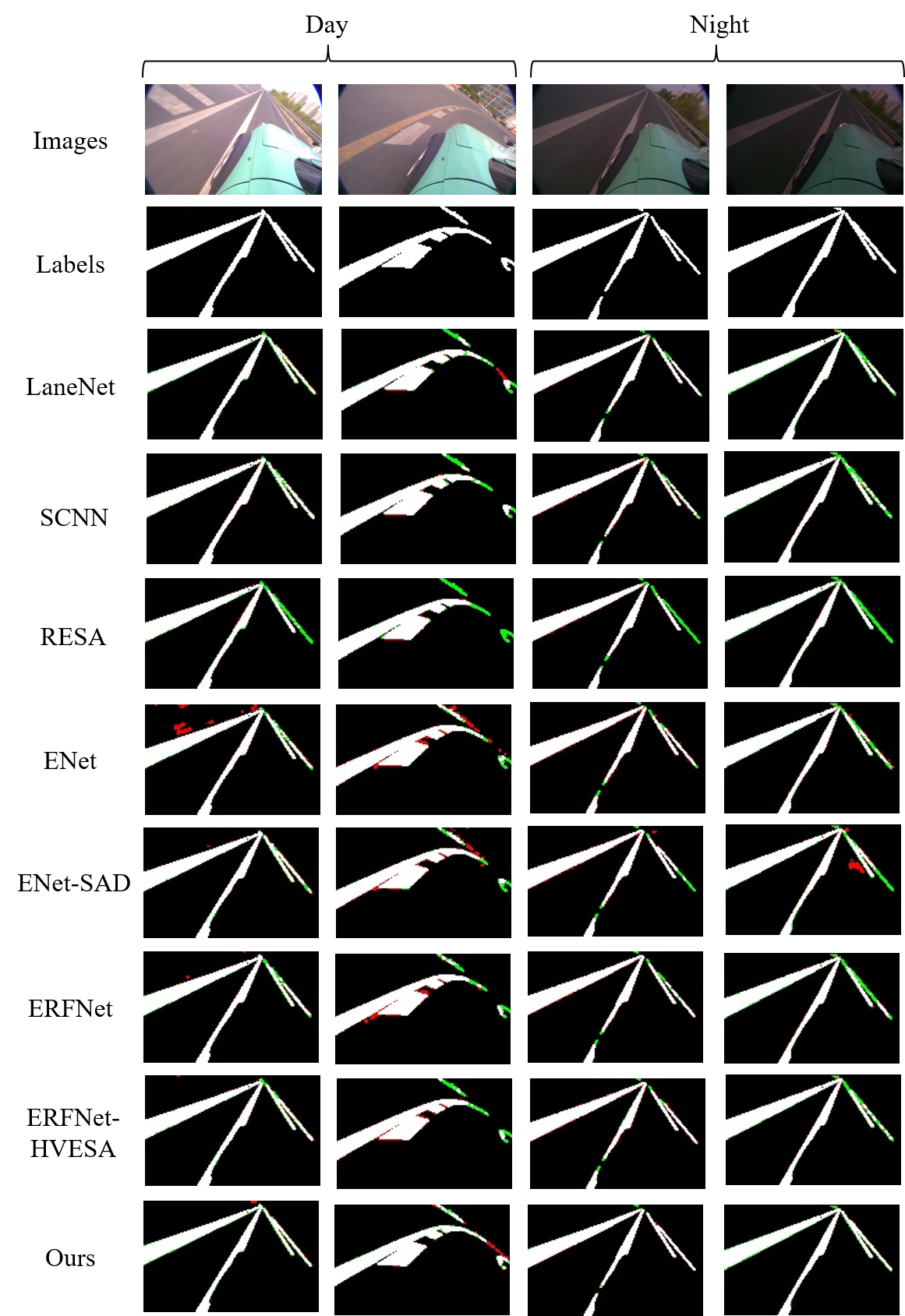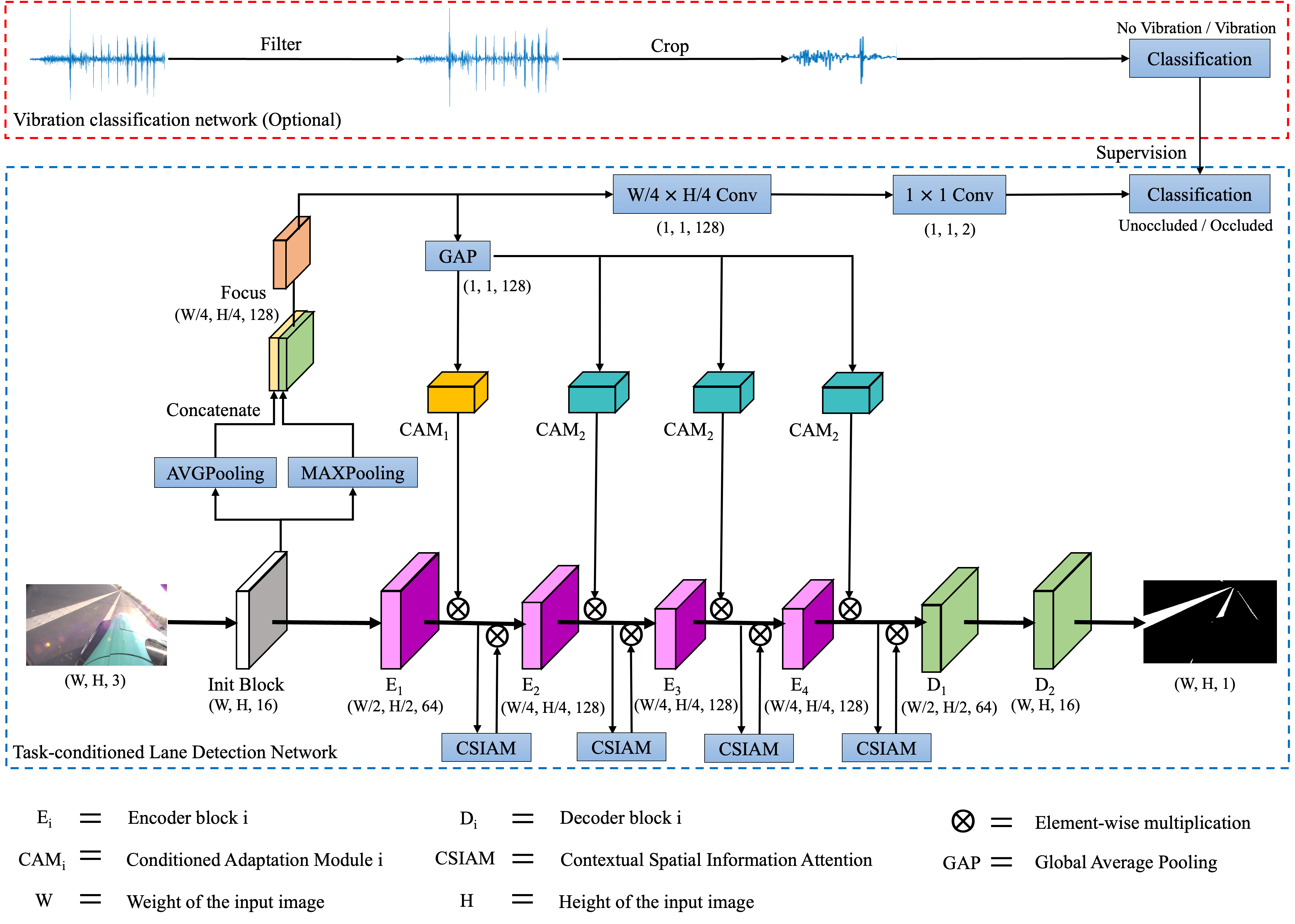Pytorch implementation of "TCLaneNet: Task-conditioned Lane Detection Network Driven by Vibration Information"
[2022-2-13] Release the initial code for TCLaneNet.
Demo trained with VBLane Dataset.
 The visualization results compared with other methods, where red and green represent false positive and false negative respectively.
The visualization results compared with other methods, where red and green represent false positive and false negative respectively.
- pytorch
- opencv
- numpy
-
VBLane dataset path (click to expand)
VBLane_path ├─ no ├─ ano_heng_1-2021-04-12-18-45-23 ├─ ano_heng_2-2021-04-12-18-47-00 ├─ ano_heng_3-2021-04-12-18-48-28 ├─ ano_road_1-2021-04-12-18-37-12 ├─ ano_road_2-2021-04-12-18-39-02 ├─ ano_road_3-2021-04-12-18-40-09 ├─ yes ├─ new2_road_again_2-2021-04-12-17-52-27 ├─ new2_road_again_3-2021-04-12-17-53-30 ├─ new2_road_again_4-2021-04-12-17-54-56 ├─ new2_road_again_5-2021-04-12-17-56-39 ├─ new2_road_again_6-2021-04-12-17-58-01 └─ list ├─ train.txt ├─ test.txt
You need to change the correct dataset path in ./config.py
Dataset_Path = dict(
CULane = "/workspace/CULANE_DATASET",
Tusimple = "/workspace/TUSIMPLE_DATASET",
bdd100k = "/workspace/BDD100K_DATASET",
mydata = "/home/neu-wang/gongyan/big_data/vibration"
)First, change some hyperparameters in ./experiments/*/cfg.json
{
"model": "TCLaneNet",
# Optional: "SCNN", "LaneNet", "Enet", "Enet-SAD", "Resa", or "TCLaneNet"
"dataset": {
"dataset_name": "mydata",
"batch_size": 12,
"resize_shape": [800, 288]
#[800, 288] with CULane and VBLane, [640, 368] with Tusimple, and [640, 360] with BDD100K
},
...
}
And then, start training with train.py.
python train.py --exp_dir ./experiments/TCLaneNet
If the training is interrupted, the following command is used to resume.
python train.py --exp_dir ./experiments/lanenet --resume
First, change some hyperparameters in ./experiments/*/cfg.json, e.g., model_path, test.
"evaluate": {
"test": "yes",
"model_path": "./experiments/TCLaneNet/TCLaneNet_iou_best.pth"
}
Then, start testing with test.py.
python test.py --exp_dir ./experiments/TCLaneNet
What's more, if the test is yes, you can python train.py --exp_dir ./experiments/TCLaneNet.
- VBLane dataset
| Method | Rec | Pre | F1 | ACC | IoU |
|---|---|---|---|---|---|
| LaneNet | 97.67 | 95.28 | 96.46 | 99.41 | 93.18 |
| SCNN | 93.34 | 97.32 | 95.28 | 99.21 | 91.02 |
| RESA | 96.81 | 95.56 | 96.17 | 99.38 | 92.65 |
| ENet | 92.53 | 97.85 | 95.11 | 99.18 | 90.69 |
| ENet-SAD | 94.62 | 96.65 | 95.62 | 99.27 | 91.62 |
| ERFNet | 97.64 | 92.86 | 95.25 | 99.20 | 91.21 |
| ERFNet-HVESA | 96.65 | 94.78 | 95.64 | 99.31 | 91.82 |
| TCLaneNet (ours) | 98.53 | 95.64 | 97.06 | 99.51 | 94.29 |
Compared with other methods, our method has better performance in F1, IoU and ACC.
This repo is built based on ENet-SAD, ENet-SAD-Pytorch, PyTorch-ENet, and SCNN_Pytorch.

